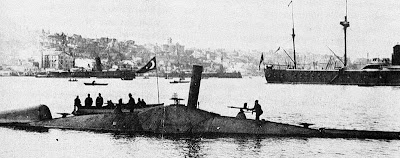"Ram Anything Painted Gray” – Wilhelm von Tegetthoff before the Battle of Lissa(1866)
The Austro-Prussian War (1866) was fought between the Austrian Empire on one side, and Prussia and the Kingdom of Italy on the other side. Prussia sought to gain greater control over Germany, while Italy wanted to take Venetia from the Austrians.. The largest naval engagement occurred near the island of Lissa in the Adriatic Sea. There an Austrian fleet of ironclads and steam powered wooden ships fought a larger Italian fleet. The Austrians caught the Italians unprepared and succeeded in “crossing the T” of the Italian fleet. The heavy side belt armor of the ironclads was invulnerable to gunnery, and the most effect offensive tactic was ramming. The Austrian fleet emerged victorious. In the war, however, Austria was defeated and ceded territory to both Prussian and Italy.
In more modern examples, many 19th Century ironclad battleships were so equipped. The first modern ram ship built was the French-built Taureau, in 1863. In fact, many ironclad ships were designed specifically to ram opponents. In ships of this type, the armour belt was prolonged to brace both sides of the ram to increase structural integrity.

The theory behind the revival of the weapon derived from the fact that, in the period around 1860, armour held superiority over the ship-mounted cannon. That is to say, it was believed that an armoured warship could not be seriously damaged by the naval artillery in existence at the time. In order to achieve a decisive result in a naval engagement, therefore, alternative methods of action were believed to be necessary. As it followed, from the same belief, that a ship armed with a ram could not be seriously damaged by the gunfire of its intended victim, the ram became, for a brief period, the main armament of Royal Navy and contemporary foreign battleships.
The frequent use of ramming as a tactic in the Battle of Lissa (1866) also led to many late nineteenth century naval designers equipping their warships with ram bows. This only really aggravated a number of incidents of ships being sunk by their squadron-mates in accidental collisions as ramming never featured as a viable battle tactic again. The fixation on ramming may also have inhibited the development of gunnery.
When it became clear, towards the end of the nineteenth century, that breech-loading cannon could hit, and hit effectively, enemy ships at several thousand yards range, the ineffectiveness of the ram became clear and ships ceased to be fitted with them.
No other ironclad was ever sunk by an enemy ship in time of war by the use of the ram, although the ram was regarded by all major navies for some thirty years as primary battleship armament. A number of ships were, however, rammed in peacetime by ships of their own navy. The most serious in terms of loss of life was the collision between HMS Victoria and HMS Camperdown,[Tas's note - a young John Jellicoe, the RN Fleet Commander at the Battle of Jutland, narrowly escaped death in this incident] which took place in the Mediterranean in 1893. The only battleship over submarine victory in history occurred during World War I, when the battleship HMS Dreadnought rammed and sank a German U-Boat, but this was incidental, and Dreadnought’s bow was not intended for ramming enemy vessels.
http://warandgame.wordpress.com/2007/12/07/ironclad-ram-doctrine/


 I also like the options for seperate throw down islands and coastline.
I also like the options for seperate throw down islands and coastline.






 The model comes in 5 separate parts: hull, 2 main turrets, breastwork superstructure and mast. All part were very crisply cast with no flash at all. All fit together nicely with no filler required. One particularly good feature is that the breastwork structure fits over the turrets, which in tun have a peg and hole fitting. This means that they the turrets can be painted and fitted without gluing, so they can rotate freely.
The model comes in 5 separate parts: hull, 2 main turrets, breastwork superstructure and mast. All part were very crisply cast with no flash at all. All fit together nicely with no filler required. One particularly good feature is that the breastwork structure fits over the turrets, which in tun have a peg and hole fitting. This means that they the turrets can be painted and fitted without gluing, so they can rotate freely.
























